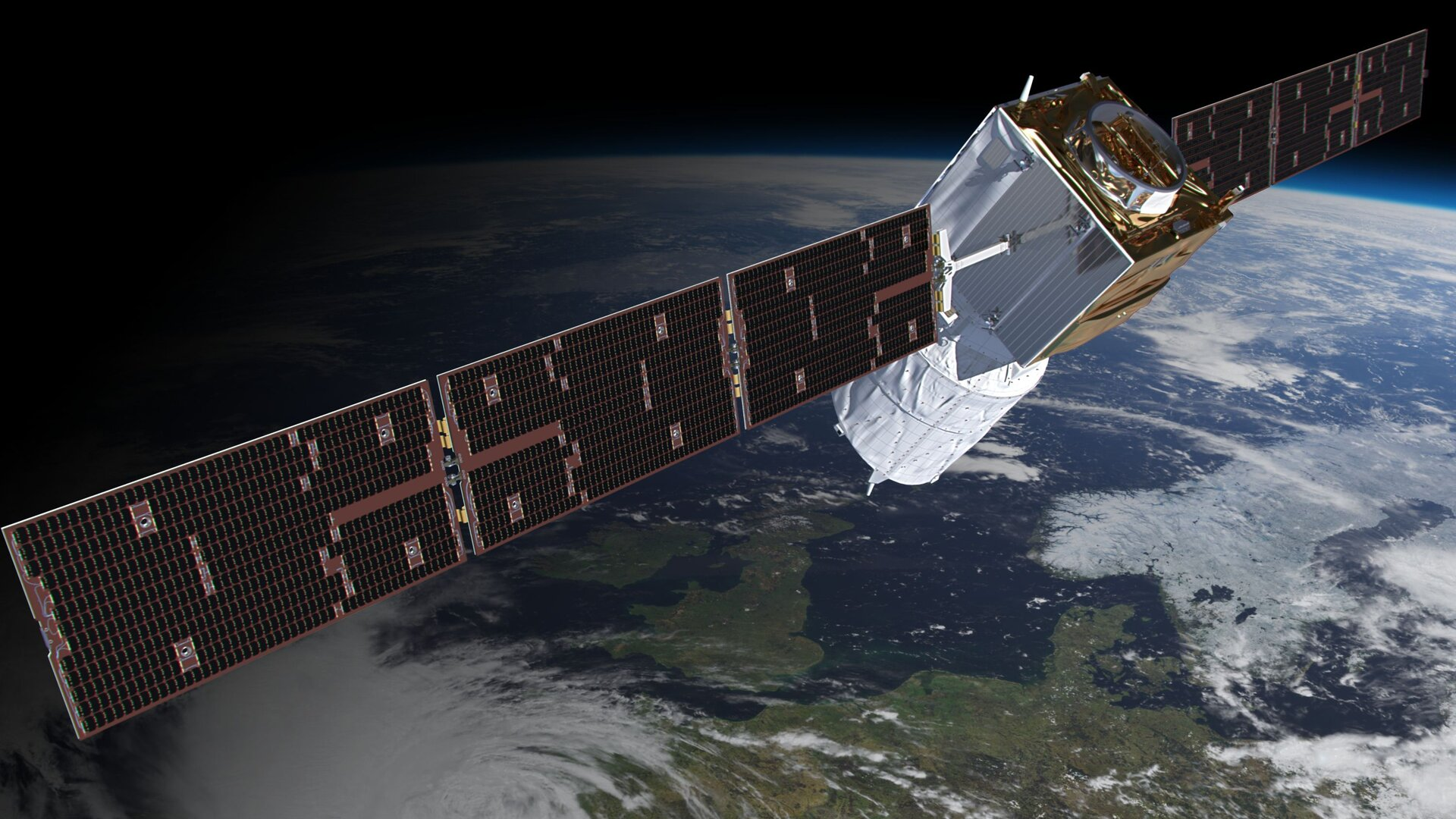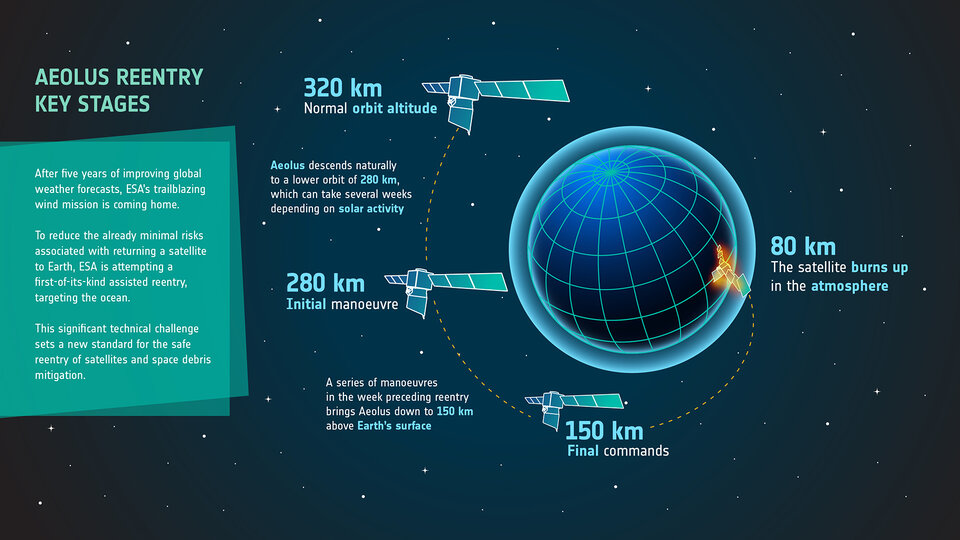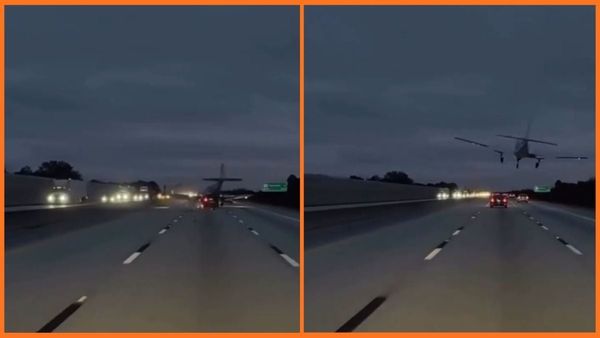
Scientists are preparing for a "first-of-its-kind" operation to steer a dead satellite back to Earth in a safe assisted re-entry.
The satellite that will be the subject of this guided return to Earth is the European Space Agency (ESA) wind-monitoring Aeolus spacecraft. At a press conference on Wednesday (July 19), ESA scientists explained how they will attempt to guide the return of Aeolus to Earth, which should happen on Friday, July 28.
"This is quite unique, what we're doing. You don't find really examples of this in the history of spaceflight," head of ESA's Space Debris Office Holger Krag said during the press briefing. "This is the first time to our knowledge, we have done an assisted re-entry like this."
Related: Australian Space Agency investigating possible rocket debris found on beach
Aeolus, referred to as the "impossible mission" because of its challenges and technological developments needed to make it work, was the first satellite to measure the winds of Earth from space in 2018.
It has been conducting this mission for five years, providing data to Europe's leading meteorology centers, significantly improving global weather forecasts, and thus becoming one of the highest-impact weather satellites ever placed in orbit before reaching the end of its operational life in April of this year. The satellite was finally turned off in early July.
Since then, the ESA satellite has been plummeting to Earth at an increasing speed falling from an altitude of 200 miles (320 kilometers)at a rate of around 0.62 miles (1 kilometer) a day, thus providing a unique opportunity to perform a guided re-entry attempt.
When and where will Aeolus come down?
Planned in the 1990s, Aeolus wasn't designed with a guided re-entry in mind, and in normal circumstances, the ESA satellite would have simply undergone a natural descent back to the planet. In this case, however, scientists at ESA's Space Operations Center in Germany will use the craft's remaining fuel to steer Aeolus to the optimal point for re-entry.

The operation to bring Aeolus back to Earth begins on Monday (July 24) ESA Spacecraft Operations Manager Isabel Rojo Escude-Cofiner said during the press briefing. By Monday, the craft should have reached an altitude of 174 miles (280 kilometers) over Earth. The initial maneuvers will lower Aeolus to 155 miles (250 km) to put it in an elliptical orbit around the planet.
"This will then be followed three days later by another set of maneuvers intended to lower it even further from 155 miles (250 km) to 93 miles (150 km) altitude," ESA Spacecraft Operations Manager Isabel Rojo Escude-Cofiner said during the press briefing.
The final maneuver will happen on Friday (July 28), when the altitude of Aeolus will be further reduced to around 62 miles (100 km) over Earth. Within five hours of that final maneuver on Friday evening, the re-entry of Aeolus will occur.
Escude-Cofiner explained that the satellite's descent corridor will bring it down over the Atlantic Ocean. As it falls, Aeolus will be tracked by a series of radar systems on the ground, allowing ESA experts to continue guiding it.
Rest in pieces Aeolus
Even if this assisted reentry procedure goes according to plan, not all of Aeolus will make it back to Earth. The satellite will begin the shake and jolt around at about 50 miles (80 kilometers) over Earth, where it will begin disintegrating.
Krag said that the ESA team expects just 20% of the satellite to survive reentry, with 80% of Aeolus burning up in Earth's atmosphere. Krag explained that this 20% survival-rate is expected for such operations.
The team hasn't narrowed down a target landing zone, and as Aeolus won't come down in one piece meaning its landing zone effectively covers more or less the whole ocean area, according to Krag.
As a result, there are no plans to recover the parts that do survive the journey back to Earth from their watery grave, with Krag adding: "We will not see any of these parts again."
With no plans in place to recover any of Aeolus, it is reasonable to ask what the purpose of this re-entry operation is.
The development of satellite reentry maneuvers such as this is vital due to the increased use of the space immediately surrounding Earth.
"Today, we have 10,000 spacecraft in space, of which 2000 are not functional. In terms of mass, we are speaking about 11,000 tons," Krag said, adding that around 100 tons of human-made space debris fall back to Earth each year, with large objects re-entering Earth's atmosphere approximately at a rate of around one per week.
According to Krag, with more objects launched into space than ever before, this rate of space junk re-entry is only set to increase, and though falling debris from orbit has yet to damage property or cause injury, such events can't completely be ruled out.
"Typically 20 to 30% of the spacecraft mass can survive the re-entry, and although the likelihood of damage or injury is very small, we take this very seriously, and future spacecraft will have to be designed to do a controlled re-entry," Krag explained.
The guided return to Earth of Aeolus should lay the groundwork for these operations in accordance with new rules for space, which Krag compares to taking things to National Parks: "The things you take in with you, you take out again after the mission."







